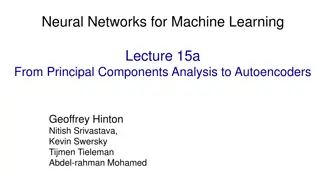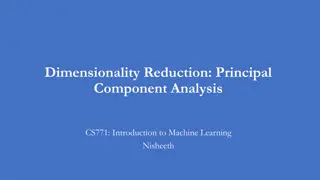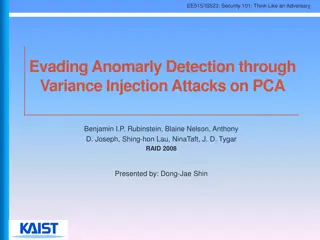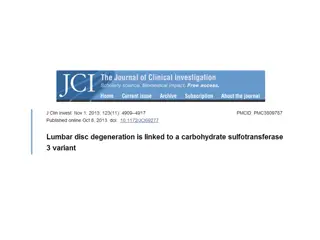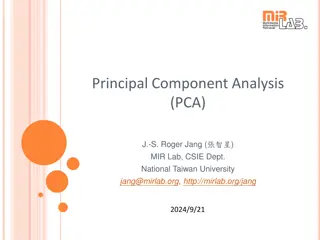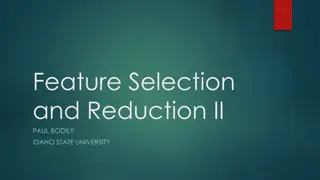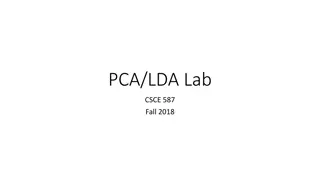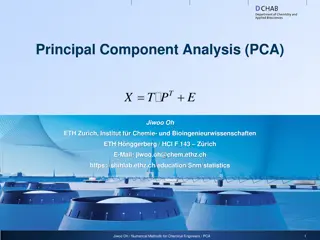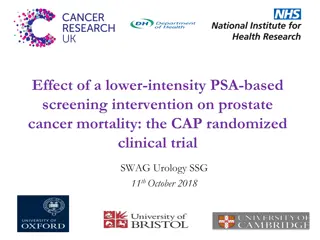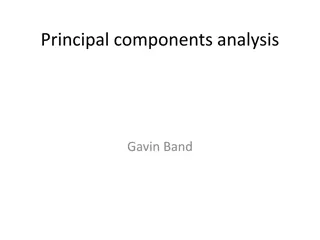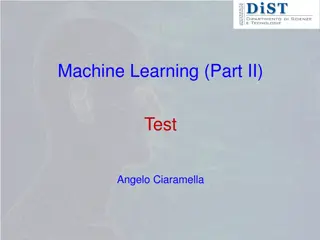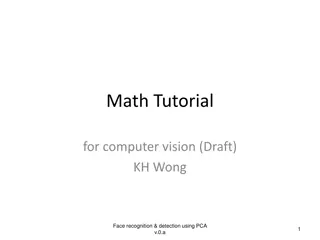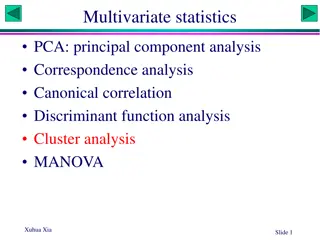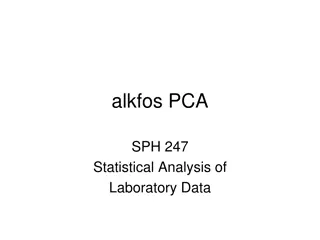Excel with Confidence PCA Linux Foundation Prometheus Certified Associate Exam Mastery
The PCA exam with confidence. Master the Linux Foundation Prometheus Certified Associate certification with comprehensive study materials, practice tests, and expert guidance. Gain the skills and knowledge needed to excel in Prometheus monitoring and alerting. Our resources will help you navigate th
8 views • 5 slides
Bioinformatics for Genomics Lecture Series 2022 Overview
Delve into the Genetics and Genome Evolution (GGE) Bioinformatics for Genomics Lecture Series 2022 presented by Sven Bergmann. Explore topics like RNA-seq, differential expression analysis, clustering, gene expression data analysis, epigenetic data analysis, integrative analysis, CHIP-seq, HiC data,
4 views • 36 slides
Strategic Planning for Post-Clearance Audit (PCA) Based on WCO Guidelines
Explore the strategic planning aspects of Post-Clearance Audit (PCA) in line with WCO guidelines. Understand what PCA entails, its objectives, benefits, and limitations. Learn how PCA ensures compliance, verifies revenue, facilitates international trade, and more. Discover the importance of PCA as a
21 views • 19 slides
Principal Components Analysis (PCA) and Autoencoders in Neural Networks
Principal Components Analysis (PCA) is a technique that extracts important features from high-dimensional data by finding orthogonal directions of maximum variance. It aims to represent data in a lower-dimensional subspace while minimizing reconstruction error. Autoencoders, on the other hand, are n
7 views • 35 slides
Guidelines for Post-Clearance Audit (PCA) - Implementation Steps
Understanding the steps involved in the implementation of Post-Clearance Audit (PCA) is crucial for effective customs procedures. This guide outlines the process, from developing audit programs to conducting field audits and reporting. Selection processes, pre-audit research, and notification proced
15 views • 11 slides
Dimensionality Reduction and Principal Component Analysis
Dimensionality reduction techniques like Principal Component Analysis (PCA) help in transforming high-dimensional data into a lower-dimensional space, leading to efficient storage and better understanding of underlying patterns. By capturing maximum variance in the data, PCA learns projection direct
9 views • 16 slides
Issues and Developments in the 15th South West Pacific Hydrographic Commission Conference
Legislation expertise remains a challenge in the conference discussions. UKHO offered support for Nauru's position, exploring options for PCA. Maritime and port operations are focal points, with Australia considering a role as PCA. Technical assessments and assistance are on the agenda for future co
9 views • 1 slides
An Overview of Evading Anomaly Detection using Variance Injection Attacks on PCA
This presentation discusses evading anomaly detection through variance injection attacks on Principal Component Analysis (PCA) in the context of security. It covers the background of machine learning and PCA, related work, motivation, main ideas, evaluation, conclusion, and future work. The content
4 views • 19 slides
Ancestry and Traits Through SNPedia and PCA Analysis
Delve into the world of genetics and ancestry analysis through SNPedia, a comprehensive resource for Single Nucleotide Polymorphisms (SNPs) information. Discover how Principle Component Analysis (PCA) simplifies genetic data to reveal insights into ancestry, traits, and informative SNPs. Explore exa
2 views • 33 slides
Comprehensive Guide to Reporting in Personal Care Assistance Assessment
The report outlines the importance of accurate reporting in Personal Care Assistance (PCA) assessments, emphasizing compliance with regulations and the need for current information. It provides guidance on submitting PCA reports, ensuring accuracy in claimant details, and avoiding misleading informa
1 views • 16 slides
Tips for Presenting PCA and Traffic Pleas in Local Court
Explore essential tips and reminders for presenting PCA and other traffic pleas in the local court from evidence preparation to sentencing considerations. Covering topics from alcohol alternatives to disqualification, this content offers valuable insights for legal professionals and learners alike.
4 views • 27 slides
Principal Component Analysis (PCA) in Data Analysis
Introduction to Principal Component Analysis (PCA) by J.-S. Roger Jang from MIR Lab, CSIE Dept., National Taiwan University. PCA is a method for reducing dataset dimensionality while preserving spatial characteristics. It has applications in line/plane fitting, face recognition, and machine learning
0 views • 23 slides
Overview of V*LIDORT and Other Radiative Transfer Models by Robert Spurr
The presentation provides an update on the status of V*LIDORT and other radiative transfer models as discussed at the Third TEMPO Science Team Meeting. It covers the LIDORT family overview, upgrades to the codes, new releases for RT models, and accelerated RT developments using PCA. The V*LIDORT cod
1 views • 12 slides
Feature Selection and Reduction Techniques Using PCA
In machine learning, Principal Components Analysis (PCA) is a common method for dimensionality reduction. It helps combine information from multiple features into a smaller set, focusing on directions of highest variance to eliminate noise in the data. PCA is unsupervised and works well with linear
0 views • 18 slides
PCA/LDA Lab
This lab focuses on exploring the concepts of Principal Component Analysis (PCA) and Linear Discriminant Analysis (LDA) using the iris dataset. It covers step-by-step instructions on performing PCA to extract independent variables, generating principal components, calculating variance, plotting comp
3 views • 17 slides
Product Conformity Assessment in Tanzania & Mozambique
The process of Product Conformity Assessment (PCA) in Tanzania and the Single Window system in Mozambique. Understand the importance of conformity assessment, the routes for certification, involved parties and activities, and the significance of Pre-shipment Verification of Conformity (PVOC). Discov
0 views • 17 slides
Principal Component Analysis (PCA)
Principal Component Analysis (PCA) is a statistical method used to analyze high-dimensional data matrices. It involves finding the principal components that best represent the data points in a lower-dimensional space. The process includes geometric interpretations such as representing data points in
1 views • 19 slides
Effect of Lower-Intensity PSA-Based Screening on Prostate Cancer Mortality
The CAP randomized clinical trial explores the impact of a lower-intensity PSA-based screening intervention on prostate cancer mortality. Context from ERSPC, PLCO, and ProtecT studies is provided, highlighting the balance of benefits and harms in men. Objectives include estimating the effect of a si
2 views • 22 slides
Linear Regression and PCA Analysis
This poster covers the fundamentals and applications of linear regression and principal component analysis (PCA). It explains the concepts, mathematical models, and practical implications of these techniques in data analysis and machine learning. Detailed figures and illustrations are provided to ai
0 views • 31 slides
Principal Components Analysis for Detecting Major Data Variations
Principal Components Analysis (PCA) is a powerful method for identifying significant directions of variation in data sets. It is particularly adept at revealing hidden structures like population subgroups with diverse allele frequencies and uncovering unexpected relationships or errors. By performin
3 views • 20 slides
Detecting Major Data Variation Directions
Principal Component Analysis (PCA) is effective in identifying significant variation directions in data, including population structures, cryptic relationships, and genotyping errors. Performing PCA involves processing genotype data, forming a relatedness matrix, and eigen-decomposing it to highligh
2 views • 13 slides
Professional Certification Agency for Disaster Management: Vision and Mission
Professional Certification Agency for Disaster Management (PCA-DM) was established to assess and certify the competence of humanitarian workers and volunteers in disaster management. Their vision is to provide competent human resources with high integrity, while their mission includes developing pro
2 views • 42 slides
Empirical Orthogonal Functions (EOF) and Principal Component Analysis (PCA)
This text delves into the concept of Empirical Orthogonal Functions (EOF) and Principal Component Analysis (PCA) in meteorology, discussing methods, definitions, and the covariance matrix used in analyzing space-time relationships. It explains how EOFs help in reducing the dimensionality of data set
3 views • 37 slides
Principal Component Analysis (PCA) and Neural Networks Overview
Explore the concepts of Hebbian learning, hierarchical PCA neural networks, second-order methods, principal components, and projection error minimization in the context of machine learning. Understand the principles behind PCA, its application in data visualization, and its significance in signal pr
1 views • 26 slides
Principal Component Analysis (PCA)
Principal Component Analysis (PCA) is a statistical procedure used to convert correlated variables into linearly uncorrelated principal components. Its main goal is to identify patterns, detect correlations, and reduce dimensionality to increase computational efficiency while retaining information.
2 views • 20 slides
Methods of Dimension Reduction in Ecology and Environmental Science
Explore the use of Unsupervised Learning Methods like PCA for simplifying multivariate datasets and uncovering patterns in ecology and environmental science. Learn about ordination to classify species abundance and identify regime shifts in ecosystem structures. Discover how PCA and other ordination
1 views • 19 slides
Singular Value Decomposition (SVD) and Principal Component Analysis (PCA)
Explore the concepts of Singular Value Decomposition and Principal Component Analysis, including definitions, applications, and algorithms. Learn how SVD is utilized in PCA to analyze high-dimensional data efficiently. Discover the motivation behind PCA and its importance in reducing computational c
3 views • 11 slides
Computer Vision Tutorial for Face Recognition & Detection using PCA
Explore a comprehensive math tutorial for computer vision focusing on face recognition and detection using PCA. Dive into topics such as basic and advanced geometry, linear algebra, non-linear optimization, probability, points and lines in 2D and 3D, and more. Enhance your understanding of image pro
4 views • 70 slides
Advanced Multivariate Statistics Techniques: PCA, Cluster Analysis, and More
Explore advanced multivariate statistical techniques such as Principal Component Analysis (PCA), Cluster Analysis, and determining the number of clusters using within-group sum of squares. Follow along with examples and visualizations to enhance your understanding of these methods.
0 views • 6 slides
Physical Education Curriculum at PCA - Engaging and Challenging Activities
Explore the Physical Education curriculum at PCA, designed to enhance pupils' physical abilities through engaging and enjoyable experiences. Develop a healthy, active lifestyle while fostering teamwork, respect, and passion.
3 views • 11 slides
Component Analysis for Spatial Audio Reproduction
Explore the innovative approach of Multi-Shift Principal Component Analysis for spatial audio reproduction to achieve a flexible and efficient representation of sound scenes in digital media, addressing the limitations of existing sound scene representations. The concept involves Primary-Ambient Ext
1 views • 15 slides
Combined PCA Analysis of Human Coronary Artery Smooth Muscle Cells
This study presents a combined analysis of ENCODE DNase-Seq and ATAC-Seq data to explore the clustering of human coronary artery smooth muscle cells. Principal Component Analysis (PCA) was utilized for normalization across datasets, providing insights into the underlying genomic architecture of thes
3 views • 25 slides
Guiding Principles of PCA Assessment: An Overview
Explore the guiding principles of Personal Care Assistance (PCA) assessment, focusing on capturing all the claimant's needs efficiently. The assessment tool is detailed and functional, assessing essential activities and special requirements for supervision. Conducted primarily at the claimant's resi
2 views • 11 slides
Statistical Analysis of Laboratory Data Using PCA and LDA Techniques
Explore the statistical analysis of laboratory data employing Principal Component Analysis (PCA) and Linear Discriminant Analysis (LDA). The data includes variables like alkaline phosphatase (alkfos) levels, grouped data, complete cases analysis, and prediction of group classifications. Visualizatio
2 views • 8 slides
Understanding Principle Component Analysis: A Comprehensive Guide
Delve into the world of Principle Component Analysis (PCA) to uncover its significance in data dimensionality reduction, with a focus on its goal, mathematical interpretations, and practical applications. Explore the geometric meanings of PCA and the covariance matrix, shedding light on the quest fo
3 views • 19 slides
Advanced Feature Selection Techniques in Data Analysis
Explore the intricacies of feature selection with Professor V.B. More at MET's IOE in BKC, Nashik. Dive into topics like creating training and test sets, managing categorical data, handling missing features, scaling and normalizing data, and utilizing techniques like Sparse PCA and Kernel PCA for im
1 views • 21 slides
Understanding Principal Component Analysis (PCA) for High-Dimensional Data
Explore the power of Principal Component Analysis (PCA) and its role in learning representations for high-dimensional data sets. Discover how PCA, along with other techniques like Kernel PCA and ICA, can extract hidden structures efficiently, leading to better visualization, resource optimization, a
0 views • 22 slides
Understanding Principal Component Analysis: Key Concepts and Applications
Explore the underlying concepts and practical applications of Principal Component Analysis (PCA) in data processing, feature extraction, and dimensionality reduction. Learn how PCA helps in efficiently representing data and identifying patterns for tasks like classification, visualization, and noise
2 views • 20 slides
Understanding PCA and Mahalanobis Distance in Multivariate Gaussian Analysis
Delve into the concepts of Principal Component Analysis (PCA) and Mahalanobis Distance as they relate to the covariance matrix, positive definite matrices, and multivariate Gaussian distributions. Explore examples and applications to gain insights into these fundamental statistical techniques.
0 views • 34 slides
Understanding Singular Value Decomposition (SVD) and Principal Component Analysis (PCA)
Learn about Singular Value Decomposition (SVD) and Principal Component Analysis (PCA) techniques for matrix analysis, including the process of eigenvector-eigenvalue decomposition, application of SVD to non-square matrices, and calculation of important components. Explore the steps involved in SVD,
0 views • 64 slides



